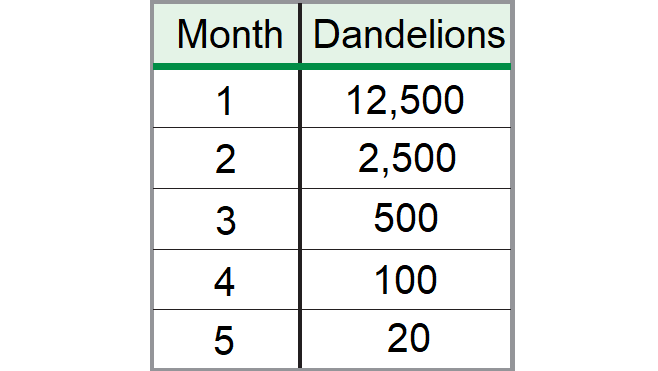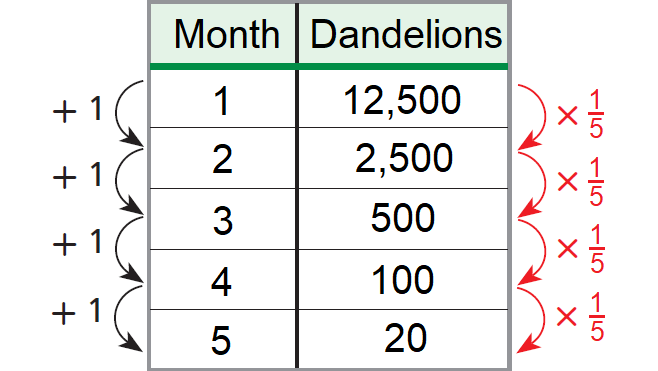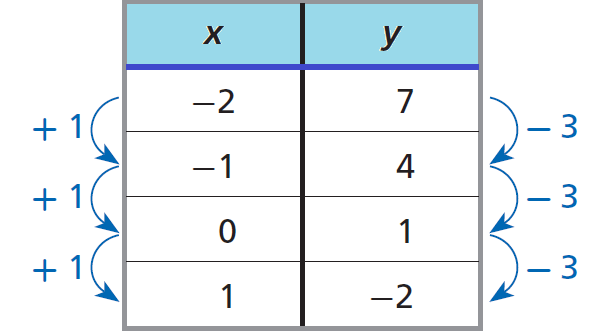SAT MATH QUESTIONS ON EXPONENTIAL VS LINEAR GROWTH
Subscribe to our ▶️ YouTube channel 🔴 for the latest videos, updates, and tips.
Question 1 :
The value of a stock is going up by 200% every hour. Which of the following best describes the relationship between time (in hours) and the value of the stock?
A) Increasing linear
B) Decreasing linear
C) Exponential growth
D) Exponential decay
Answer :
Let $1 be the value of the stock in the 1st hour.
Since the value of a stock is going up by 200% every hour, the value of the stock is $2 in the 2nd hour, $4 in the 3rd hour, $8 in the 4th hour and so on.
When there is a constant change +1 in time, the value of the stock is increasing by a constant factor 2 (multiplied by 2).
This relationship represents exponential growth.
The correct answer choice is (C).
Question 2 :
Of the following scenarios, which one would result in exponential decay of the total amount of money kept in a safe?
A) The owner withdraws a third of the money remaining in the safe every month.
B) The owner withdraws 100 dollars every month from the safe.
C) The owner withdraws 10% of the original amount of money in the safe of every month
D) The owner empties the account in five months by withdrawing an equal amount of money each month.
Answer :
Linear growth/decay :
A constant change in one quantity corresponds to a constant change in another quantity.
Exponential growth/decay :
A constant change of in one quantity corresponds to an increase/decrease in another quantity by a constant factor.
Choice A :
A constant change +1 in months corresponds to a decrease in the amount of money in the safe by a constant factor 1/3.
This relationship represents exponential decay.
Choice B :
A constant change +1 in months corresponds to a constant decrease $100 in the amount of money in the safe.
This relationship represents linear decay.
Choice C :
A constant change +1 in months corresponds to a constant decrease (10% of the original amount) in the amount of money in the safe.
This relationship represents linear decay.
Choice D :
A constant change +1 in months corresponds to a constant decrease (equal amount of money each month) in the amount of money in the safe.
This relationship represents linear decay.
The correct answer choice is (A).
Question 3 :
The number of dandelions in a large park is recorded over the course of five months, as shown in the table below.

Which of the following best describes the relationship between time and the number of dandelions during the five months?
A) Increasing linear
B) Decreasing linear
C) Exponential growth
D) Exponential decay
Answer :
Look for a pattern in the given table.

When there is a constant change +1 in months, the number of dandelions is decreasing by a constant factor 1/5 (< 1).
This relationship represents exponential decay.
The correct answer choice is (D).
Question 4 :
Tom buys a pack of baseball cards everyday. Each pack contains 7 cards but he gives away the two least valuable ones to his brother Which of the following best describes the relationship between time (in days) and the total number of baseball cards in Tom's collection?
A) Increasing linear
B) Decreasing linear
C) Exponential growth
D) Exponential decay
Answer :
Day 1 :
Number of cards Tom has = 7 - 2 = 5
Day 2 :
Number of cards Tom has = 5 + 7 - 2 = 10
Day 3 :
Number of cards Tom has = 10 + 7 - 2 = 15
Day 4 :
Number of cards Tom has = 15 + 7 - 2 = 20
A constant change +1 in days corresponds to a constant increase of 5 in number of cards.
This relationship represents linear growth.
The correct answer choice is (A).
Question 5 :
{(-2, 7), (-1, 4), (0, 1), (1, -2)}
Which of the following best describes the relationship represented by the above set of ordered pairs?
A) Linear growth
B) Linear decay
C) Exponential growth
D) Exponential decay
Answer :
Write the ordered pairs in a table and look for a pattern.

In the table above, a constant change of +1 in x corresponds to a constant change -3 in y.
Therefore, the relationship given in the table above represents linear decay, because each y-value is 3 less than the value before it.
The correct answer choice is (B).
Question 6 :
y = 2x + 3
Which of the following best describes the relationship represented by the equation above?
A) Linear growth
B) Linear decay
C) Exponential growth
D) Exponential decay
Answer :
Substitute values for x with constant difference, say
x = 1, 2, 3, 4
Substitute those values of x in the given equation and evaluate the values of y.
When x = 1,
y = 2(1) + 3
= 2 + 3
= 5
When x = 2,
y = 2(2) + 3
= 4 + 3
= 7
When x = 3,
y = 2(3) + 3
= 6 + 3
= 9
When x = 4,
y = 2(4) + 3
= 8 + 3
= 11
When x = 1, 2, 3, 4,
y = 5, 7, 9, 11
A constant change of +1 in x corresponds to a constant change of +2 in y.
Hence, the given equation represents a linear growth.
The correct answer choice is (A).
Question 7 :
y = 2(3)x
Which of the following best describes the relationship represented by the equation above?
A) Linear growth
B) Linear decay
C) Exponential growth
D) Exponential decay
Answer :
Substitute values for x with constant difference, say
x = 0, 1, 2, 3
Substitute those values of x in the given equation and evaluate the values of y.
When x = 0,
y = 2(3)0
= 2(1)
= 2
When x = 1,
y = 2(3)1
= 2(3)
= 6
When x = 2,
y = 2(3)2
= 2(9)
= 18
When x = 3,
y = 2(3)3
= 2(27)
= 54
When x = 0, 1, 2, 3,
y = 2, 6, 18, 54
A constant change of +1 in x corresponds to an increase in y by a constant factor of 3.
Hence, the given equation represents an exponential growth.
The correct answer choice is (C).
Subscribe to our ▶️ YouTube channel 🔴 for the latest videos, updates, and tips.
Kindly mail your feedback to v4formath@gmail.com
We always appreciate your feedback.
About Us | Contact Us | Privacy Policy
©All rights reserved. onlinemath4all.com

Recent Articles
-
90 Degree Clockwise Rotation
Jan 01, 26 06:58 AM
90 Degree Clockwise Rotation - Rule - Examples with step by step explanation -
US Common Core K-12 Curriculum Algebra Solving Systems of Equations
Jan 01, 26 04:51 AM
US Common Core K-12 Curriculum - Algebra : Solving Systems of Linear Equations -
Solving the HARDEST SAT Math Questions ONLY using Desmos
Dec 31, 25 05:53 AM
Solving the HARDEST SAT Math Questions ONLY using Desmos
